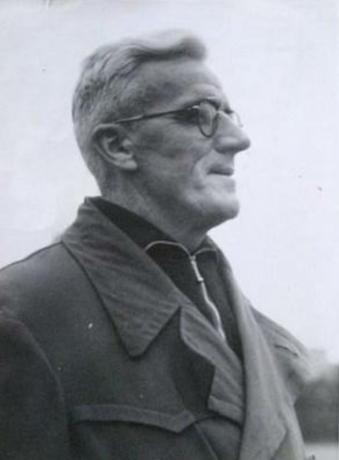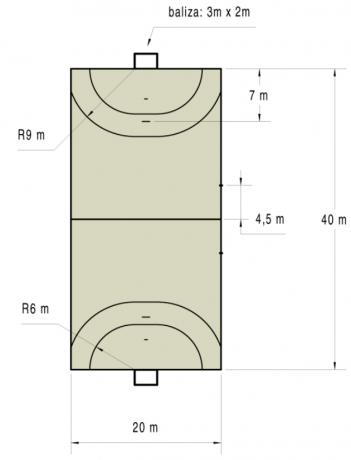O handball (or handball) is a team sport that involves passing the ball with your hands.
Practiced between two teams, the name of this sport comes from the English language, since hand means “hand”.
The handball ball is made of leather and for men's teams it has a larger diameter.
Thus, for men it is 58.4 cm in circumference and a mass of 453.6 grams. As for women, it has 56.4 cm in circumference and a mass of 368.5 grams.

Origin
Handball was created in 1919 by the German athlete and physical education teacher Karl Schelenz (1890-1956).
This year, he and other co-workers redesigned a sport for the visually impaired called torball.

History
Since its creation, handball as we know it today has undergone some modifications. The game site, for example, was outdoors (on lawns) and spaces were smaller.
Now, the sport is performed on closed courts measuring 40 by 20 meters. Also, in the beginning, handball was a game exclusively for women.
Later, with its inclusion in Olympic sports, it came to be played by both sexes.
As it was created by a German, it started to be played in Berlin, Germany during World War I.
However, it did not take long for it to spread throughout Europe and even to other parts of the world.
Another factor that differentiates it from its origin is the number of players. When it was created, it contained a total of 22 players, ie 11 on each team. Today the number has been reduced to 14 in total (7 players on each team).
In the late 1930s handball became an official sport at the Berlin Olympics. At that time, the game was still played by two teams of 11 players each.
With the new changes (players and space), it became part of the Olympic Games from 1972.
In addition, the sport has spread around the world and currently we find several competitions taking place nationally and internationally. The World Handball Championship in the female and male categories.
In 1999 the International Handball Federation based in Basel, Switzerland was founded. This body is responsible for the sport worldwide.
Today, handball is played in more than 180 countries around the world.
Handball in Brazil
In Brazil, handball started to be recognized in the 1930s. In 1940 the São Paulo Federation of Handball was founded in São Paulo. This moment was an important step towards the consolidation of the sport in the country.
In 1979, the Brazilian Handball Confederation (CBHb) was founded, headquartered in the city of Aracaju (Sergipe). This body is responsible for the handball events that take place in the country.
Currently, several states have Handball teams with highlights for São Paulo, Minas Gerais, Rio de Janeiro and Paraná.
Even though handball has some representation in the country, this sport is still the least practiced in relation to football, volleyball, basketball, etc.
Women's Handball
In the 1999 Pan American Games, which took place in Canada, the women's team won the gold medal. With that, the team was classified for the Olympic Games in Sydney (Australia) in the year 2000.
In 2013, the World Women's Handball Championship took place in Serbia. Again, the Brazilian team was champion.

Handball Fundamentals
The main fundamentals of handball are:
- Divided into two periods of 30 minutes each;
- It has a 10-minute break between each step;
- There are two referees and a timekeeper;
- The game involves dribbling, passing and receiving the ball between players;
- Throwing is a widely used technique to score goals;
- The way to hold the ball in play is called the "handle".
Handball Rules
The goal of handball is score goals. Therefore, the team that scores the most goals wins. For this, the skill and speed of the players favor the final result.
When the ball is in the player's hand, he can take up to three steps before throwing it to another player.
This is also true for time, meaning each player can keep it in their hands for 3 seconds. This makes handball a very dynamic game.
absences
Fouls are committed when the ball is touched with the feet or other parts of the body. It is also considered a foul if one player tries to snatch the ball from another player's hands.
Furthermore, and depending on the severity of the aggression between players, a foul occurs. Thus, pushing, kicking, elbowing, are considered fouls. As in football, there is the yellow and red card given by the referee.
Yellow card
The yellow card serves as a warning to the player who has committed a foul. In total, he cannot receive more than three yellow cards during a game.
If that happens, he is disqualified. In short, three yellows equal one red. On the second yellow card, the player leaves the court for 2 minutes of play.
Red card
The red card is given by the referee when the player commits a more serious foul. By welcoming him, he is out of the game and the team is down with one player for two minutes.
After this time, another player can enter the court. The red card therefore indicates the player's expulsion.
Block
The handball court is 40 by 20 meters. On each side are the respective goals that measure 2 by 3 meters. The floor is usually varnished or rubberized.

players
Handball features two teams of 7 players each. Of these 7 one of them will be the team's goalkeeper. Interesting to note that he is the only player who can put his feet on the ball, without being considered a foul.
Curiosity
In addition to indoor handball, the practice on the beach began to expand in the 1980s. Although they are similar, in beach handball the total starting time is 20 minutes. So there are two matches of 10 minutes each and a 5-minute break.
Want to learn more about other sports? Read too:
- Types of sport: invasion, brand, precision, combat, net and wall
- invasion sports
- rugby
- Soccer
- futsal
- Volleyball
- Basketball
- Swimming
- Baseball
- Athletics
- Badminton
- Fitness
- Fencing

